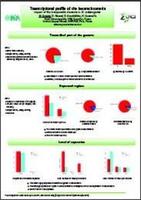
2010
ASM Conference, Mobile DNA, April 24 - 28, 2010, Montreal, Canada
25 Apr 2010 Transcriptional profile in heterochromatin: Impact of the transposable elements
M. Zytnicki, D. Nouaud, D. Anxolabéhère, H. Quesneville
We analyze the transcriptional profile of the heterochromatin and compare it to the euchromatin profile in Drosophila melanogaster. To do so, we used data available on public databanks and we sequenced through high-throughput sequencing the transcriptome extracted from ovary cells, using 454 and Solexa platforms. We chose to sequence 5’ capped transcripts, so that we could find the transcription start sites (including in the transposable elements) and the level of expression of the transcripts. First, using GenBank public data, we estimated the transcribed part of the genome. Then, we looked for the region that were expressed. Finally, we investigated the level of expression of the transcripts. All together, our work suggests that a notable part of heterochromatin, although not a important as the euchromatin part, is transcribed and that the level of transcription in heterochromatin is comparable with the level in euchromatin. Then as expected, the genes (annotated by FlyBase) are the most expressed regions. But transposable elements and intergenic regions are also quite transcribed, especially in heterochromatin. Moreover, few transposable elements are expressed at detectable levels and the average level of expression of those which are expressed is less than the level of expression of the genes. But the level of transposable elements is still far from negligible in the euchromatin and in the heterochromatin, where the two levels seem to be similar.
Besides, we also detected many transcribed regions outside genes and transposable elements, in euchromatin and heterochromatin, with significant transcription levels. We suspect that these regions, especially those which are in heterochromatin, may be involved in the formation of the heterochromatin and the silencing of the transposable elements. We are currently studying the role of the transposable elements in the formation of heterochromatin. We are looking for the genomic regions producing double-stranded transcripts and piRNAs near transposable elements, thus potentially initiating the formation of heterochromatin. We hope we will able to present new results on this analysis.
[Download pdf: 187.01 kB]
Creation date: 03 May 2010
 eZ Publish
eZ PublishPublication supervisor: A-F. Adam-Blondon
Read Credits & General Terms of Use
Read How to cite










